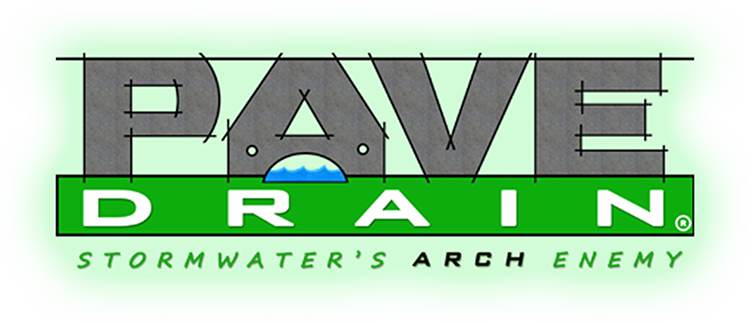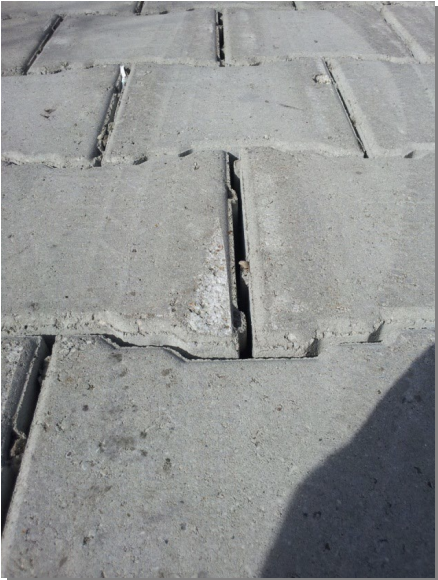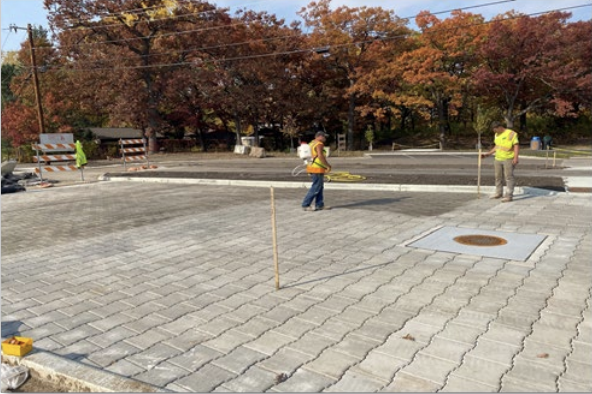What is PaveDrain’s current total cost (including labor, etc.) per square foot? What is the current cost of the material only per square foot?
Depending on your location in the U.S. and the size of your project a conservative installed cost of PaveDrain will be $15-$25/square foot.
Here is what this includes:
Hand-Placed (i.e. Palletized Blocks) is common for projects less than 5,000 Square Feet. Larger projects are typically machine installed. Most jobs have some hand placement no matter what.
$7.50 - 9.50 per square foot
Shipment of product to the jobsite (Approx. 825 Square foot per truckload)
$1.00 – $5.00 per square foot. Will obviously vary depending on fuel costs and distance that the product will be hauled.
Heavy Duty Geotextile (Ex. Mirafi RS280i or 380i is recommended)
$0.50 – 1.00 per square foot
4-6” Rock base, minimum. (3/4 – 1’ dia. Clean, angular stone, NO FINES, AASHTO #57 with an LA Abrasion of <50).
$0.50 – 1.00 per square foot
GEOGRID on TOP of AASHTO #57 Stone (Ex. Tensar BX1100 or 1200)
$0.50 - $1.00 per square foot
Installation
$2.50 - $4.50 per square foot
Prevailing wages will be higher (i.e. $5.00+/Sq.Ft.)
Sealing – Required in Northern Climates where salt/brine is utilized. Recommended for COLORED blocks to maintain color.
$1.35 - $2.50 per square foot
Tenon Salt Barrier (Formerly Pro-Spec)
https://ww.tccmaterials.com/product/tenon-salt-barrier/
2. What is the maintenance of PaveDrain?
Maintenance will vary greatly from site to site depending on the amount of debris (i.e. leaves, sand, silts, sedimentation) and storm events that occur. The open joints between the PaveDrain blocks are NOT pre-clogged by choker stone or small rock. This allows for a significant amount of debris to be broken down over time from the damp environment. The open graded aggregate bedding layer (#57) allows for a significant amount of debris to be captured as well that can later be vacuumed out.
The PaveDrain System is designed as an open joint concept between the blocks. Many existing installations have required little, if any, maintenance. If the joints become filled or obstructed, maintenance is accomplished by using a vacuum truck or a combination sewer vacuum truck and the PaveDrain Vac Head. If a significant amount of sediment accumulates in the aggregate bedding stone, part or all of the PaveDrain system can be removed allowing the subgrade to be cleaned and then the same product re-installed. Repairing individual PaveDrain blocks can also be accomplished. For more detailed information on these topics go to www.pavedrain.com and select Installation & MAINTENANCE, and then click on REPAIR.
3. What is the infiltration rate of the PaveDrain system?
The PaveDrain System® was tested in accordance with ASTM C1701/C1701M-09 by an independent third party engineering firm. The test were conducted on different PaveDrain installations that had not been maintained on an average of more than 2 years and still infiltrated in excess of 1,500 inches/hour per one foot diameter.
| Test Parameter | Test 1 | Test 2 |
|---|---|---|
| Inside Dia. of Infiltration Ring (in) | 12.19 | 12.19 |
| Elapsed Time of Test (sec) | 20.3 | 21.95 |
| Infiltration Rate (in/hr) (l=KM/(D²·t)) |
1,630 | 1,560 |
| Average Infiltration Rate (in/hr) | 1,595 | |
4. What is the loading rate of the PaveDrain system?
The PaveDrain system has been rated to AASHTO HS-25 Load Rating. http://www.pavedrain.com/pdf/specifications/PaveDrain-HS-25-AASHTO-Loading-Analysis-Letter.pdf
5. How does the PaveDrain system perform during freeze/thaw cycles?
PaveDrain is based on articulating concrete block technology that has been utilized in the U.S. for over 70 years. The system of interlocking blocks gives PaveDrain a tremendous advantage in freeze-thaw conditions over traditional systems because the system is flexible and very little freeze-thaw forces are placed on the block itself. The mix design of the block itself is derived from local block manufacturers’ knowledge and experience. It has been subjected to dozens of freeze- thaw tests (i.e. ASTM C 1262) from other products which measures a coupon cut from the block. The mix design is one critical aspect, but the articulating design of PaveDrain compliments the mix design. Unlike traditional impervious surfaces, the permeable world has rarely ever experienced freeze/thaw issue, even though water is allowed to get into the base. The open graded aggregate, which ranges from 30% to 43% depending on the aggregate size, allows the water ROOM to EXPAND when it FREEZES. Rather than put all the pressure on the surrounding aggregates and fines, which shift and move and then adversely affect the surface (i.e. traditional asphalt and concrete), we give the aggregate some room. We have never experienced a pothole with this designed open aggregate base and proper geotextile.
6. What is the percent open area of PaveDrain?
The arched storage unit comprises a 20% open area of a standard 11.9” x 11.9” x 6.00” PaveDrain unit. The surface open area is 7%.
7. Can PaveDrain come in different colors?
Yes. Similar to the retaining wall industry, PaveDrain is available in multiple colors. The most popular are earth tone colors such as tans, browns, reds and charcoal. This will typically ADD $1 - $1.50 to the square foot price and there may also be minimum production requirements (Typically around 5,000 Sft). Local manufacturing will determine which colors are available. Special colors such as blends, yellows,blue and green will be subject to increased pricing above the typical $1 per square foot price increase.
8. How PaveDrain’s broken block replaced?
The easiest way is with the PaveDrain Extraction tool. This is a modified “slab grabber” for those in the paver industry. If the joints have not been cleaned in quite some time (typical), then you may need to play “Jenga” to see which blocks around the broken unit are loose enough to remove. Once extracted it is very easy to drop a new replacement block into place. For more information go to: http://www.pavedrain.com/installation-maintenance/
9. Can the PaveDrain system be snow plowed with a steel snowplow blade?
Accidents do happen. Once or twice...yes. However, it should be noted that the edges and tops of the blocks may be scored or damaged by a steel snowplow blade (SEE BELOW). An individual PaveDrain block will not be “flipped” or “kicked out” from being struck by a snowplow blade. To prevent damage during the winter snow plowing operations from standard steel snowplow blades, it is recommended to float the steel blade 1/4-1/2” above the PaveDrain system to avoid damaging the edges of the PaveDrain blocks that MAY be sticking up due to the variances in subgrade preparation. (A rubber edge blade for plowing fixes this!) Many municipalities already float the blades on their traditional concrete and asphalt streets to protect their steel blades and roadway infrastructure. Winter care, if done improperly, typically has the greatest impact to the life of the system.
In order to minimize any surface damage to a PaveDrain block, the recommended snow plowing method would be with a rubber tipped snow blade. The following is an excerpt from a popular rubber snow blade provider. NOT AN ENDORSEMENT www.plowrubber.com
Long Lasting: Our rubber snowplow edges are made of a tough, resilient rubber compound that shows very little wear after many hours of use. They can outlast steel edges many times. No Gouging: Rubber edges easily adjust to irregular road surfaces & pavement markers-without gouging. Rubber edges save you costly repairs to submerged lighting and surfaces such as cobblestone and brick.
10. Is sealing the PaveDrain system recommended?
YES!!! IF YOUR TOWN, CITY OR STATE USES SALT...SEAL THE PAVEDRAIN BLOCK!!!
This also depends on the climate. A sealant is REQUIRED in salty, northern environments. A sealant is an economical way to assist the PaveDrain system to resist the damages caused by salt. Sealing of the PaveDrain system will increase its longevity. (EXAMPLE – Tenon Salt Barrier by TCC Materials.) https://www.tccmaterials.com/product/tenon-salt-barrier/
For warmer climates it is strongly recommended to seal the PaveDrain system on projects utilizing colored blocks (i.e. Charcoal, Rose, Brown,. etc.) The PaveDrain system can be sealed AFTER it has been installed. Due to its open joint design, the PaveDrain system will remain permeable AFTER a sealant has been applied if the joints are open and free of debris. (Excess sealant will simply run down the sides of the PaveDrain Blocks). The PaveDrain system can be sealed with a boom sprayer or any other hand or mechanical applicator for ease of installation.
Sealant being applied on installed PaveDrain via hand sprayer. Each block is basically one square foot making application rate per gallon easy.
NOTE: It is strongly recommended to vacuum/clean the PaveDrain system prior to applying a sealant.
11. What is the life expectancy of the PaveDrain system?
The PaveDrain system is based on articulating concrete block technology that has been utilized in the U.S. for over 70 years. Cleaning of the PaveDrain with a vacuum truck such as an Elgin Whirlwind® or Megawind® or a combination sewer vacuum truck and the PaveDrain Vac Head is a project specific condition. Individual blocks MAY occasionally break overtime. This does NOT constitute a system failure. Individual PaveDrain blocks can be replaced over time lengthening the lifespan of the PaveDrain system. A life expectancy of 25+ years can be expected in most installations.
12. Does the PaveDrain system conform to ADA requirements?
Yes. ADA Design Guidelines require that surfaces be firm, stable and slip resistant. Gaps between PaveDrain blocks do not exceed 1/2". The PaveDrain system easily exceeds all these requirements by incorporating a 1⁄4” gap between individual PaveDrain blocks.
13. Should different striping paint be used on PaveDrain installations?
No. A conventional striping paint utilized on conventional asphalt or concrete can be utilized on the PaveDrain system. Installations have shown that the paint sticks exceptionally well to the PaveDrain system.
14. What are the estimated LEED points that PaveDrain can qualify for?
It is up to the architect and engineer of record to determine which LEED points apply to their respective sites. The following LEED points are most commonly applicable to PaveDrain projects
SUSTAINABLE SITES
Credit 6.2 Stormwater Design, Treatment 1 Point
Limit distribution of natural water flows by managing stormwater runoff
Credit 6.2 Stormwater Design, Treatment 1 Point
Implement a stormwater management plan that reduces impervious cover, promotes on-site infiltration, and eliminates contaminants.
Credit 7.1 Heat Island Effect, Non-Roof 1 Point
Reduce heat islands.
MATERIALS & RESOURCES
Credit 5.1 Regional Materials 1 Point
10% Extracted, processed, and Manufactured Regionally. (Most materials (sand, rock, cement) for the manufacture of block is produced within 100 miles of the manufacturing facility).
Credit 5.2 Regional Materials 1 Point
20% Extracted, processed, and Manufactured Regionally. (Most materials (sand, rock, cement) for the manufacture of block is produced within 100 miles of the manufacturing facility).
INNOVATION & DESIGN PROCESS
Credit 1.2 Innovation in Design: Life-Cycle Benefits 1 Point
PaveDrain can easily be vacuumed and cleaned. Unlike traditional asphalt when it is sealed, re-painting of the pavement striping is not needed.
15. Where is the PaveDrain system manufactured?
All over the U.S. & Canada. Currently it is manufactured in 25 different locations: Including 3 licensed locations in Bladensburg, MD, Kittanning (Pittsburgh), PA and Honolulu, HI. The PaveDrain system is typically contract manufactured (~350 mi.) of the actual project. Contact info@pavedrain.com for specific projects.
16. What are the typical applications for the PaveDrain system?
Roadways, Parking Lots, Alleys, Sidewalks, Driveways, Pool Decks…









